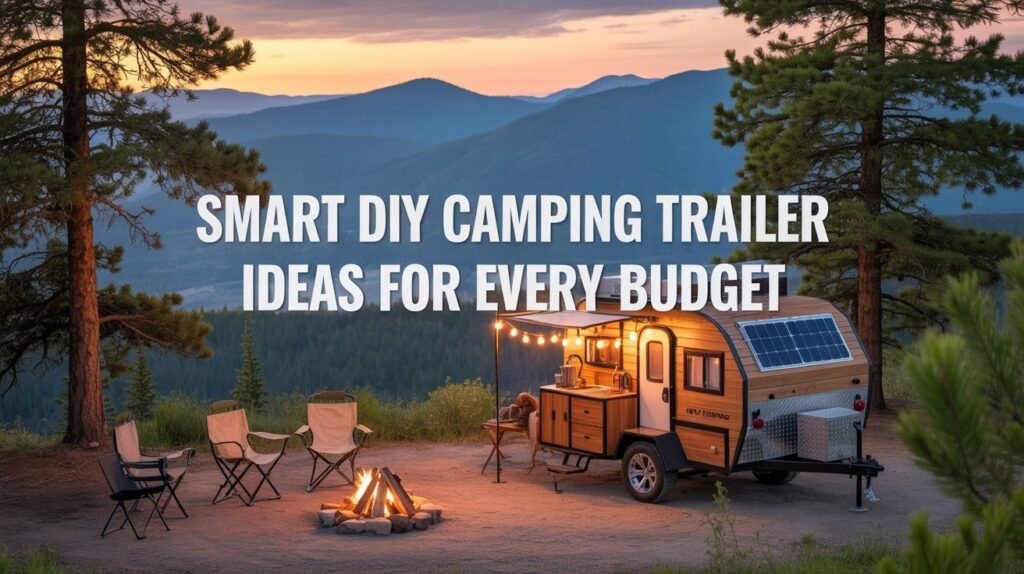More people want to camp without spending thousands of dollars on a store-bought RV. Building your own camping trailer lets you save money while creating something that fits your exact needs. You can design it the way you want and feel good about making it yourself.
This guide shares practical diy camping trailer ideas that work for different skill levels. Some projects are simple enough for beginners. Others need more time and experience. You’ll find options for small budgets and bigger builds. Each idea includes what materials you need and who it works best for.
Getting started might seem hard, but many campers have done it successfully. With the right plan and some basic tools, you can build a trailer that makes your camping trips better. Let’s look at some proven designs you can make at home.
Creative DIY Camping Trailer Ideas to Build Your Dream Mobile Retreat
These DIY camping trailer ideas offer various ways to build your own mobile camping space. Pick the one that matches your skills, budget, and camping style.
1. The Micro Tiny House Camper on a Budget Trailer

This small camper uses a 4×8 Harbor Freight trailer as its base. The compact size keeps costs down while providing you with enough room to sleep and store your gear. You can find these trailers on sale, making this one of the most affordable diy camping trailer ideas to start with.
The design includes storm windows that let in light and fresh air. A sliding bed system helps you use the space better during the day. Built-in storage keeps your camping supplies organized and easy to reach.
Most people spend between $800 and $1,500 on materials for this build. It takes about three to four weeks if you work on weekends. This trailer works great for short camping trips and can even haul a motorcycle when you’re not camping.
2. Lightweight Aluminum Frame Teardrop Trailer
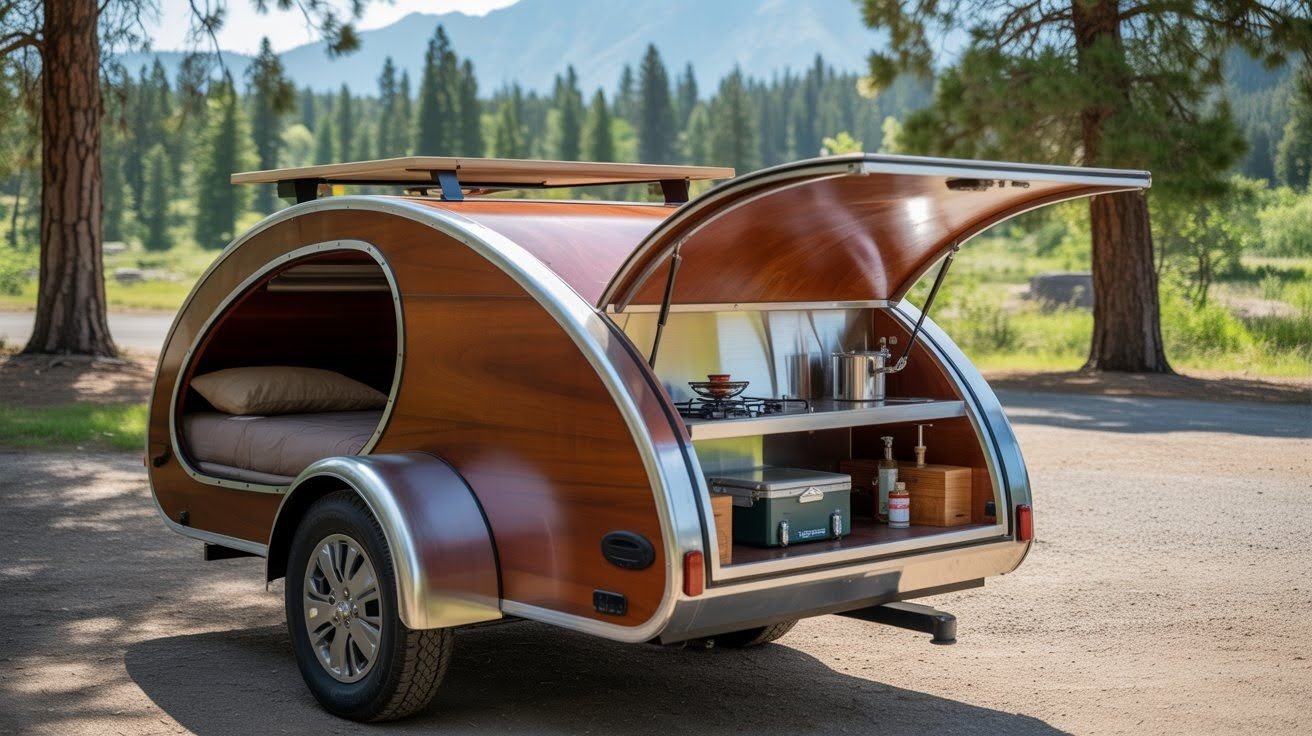
Keeping your trailer under 1000 pounds means smaller cars can tow it safely. An aluminum frame weighs much less than steel but stays strong enough for the road. Marine-grade plywood resists water damage better than regular wood.
The teardrop shape cuts through the wind easily and saves gas. Inside, you get a cozy sleeping area that fits a full-size mattress. The back opens up to reveal a small kitchen space with room for a stove and cooler.
This design suits solo campers or couples who want something light and simple. The smaller size makes it easier to park at campsites. You can build one in about six weeks with basic metalworking skills.
3. Converted Enclosed Utility Trailer Camper

Start with a 6×12 enclosed aluminum utility trailer that you can buy new or used. These trailers already have walls and a roof, which saves you construction time. You just need to add the camping features inside.
Install bunk beds along one wall to sleep multiple people. Add a small desk area for playing cards or eating meals. A portable toilet setup gives you bathroom options at remote campsites. The torsion suspension system makes the ride smoother on bumpy roads.
Families with young kids love this design because everyone has their own sleeping spot. The enclosed design protects you from bugs and bad weather. Total costs run between $2,500 and $4,000, depending on what features you add.
4. Foam Core Composite “Foamie” Trailer

Closed-cell foam insulation panels make up the walls of this ultra-light trailer. These panels weigh very little but keep the inside comfortable in hot and cold weather. The foam also provides good insulation without adding extra layers.
Cover the outside with painted cloth or fiberglass coating to protect it from the elements. This finishing layer keeps water out and makes the trailer look polished. The whole structure weighs much less than traditional wood and metal builds.
Minimalist campers who care about gas mileage prefer this option. Lightweight means your vehicle uses less fuel on long trips. This ranks among the most fuel-efficient diy camping trailer ideas you can build.
5. Boxdrop Camper on Small Utility Trailer
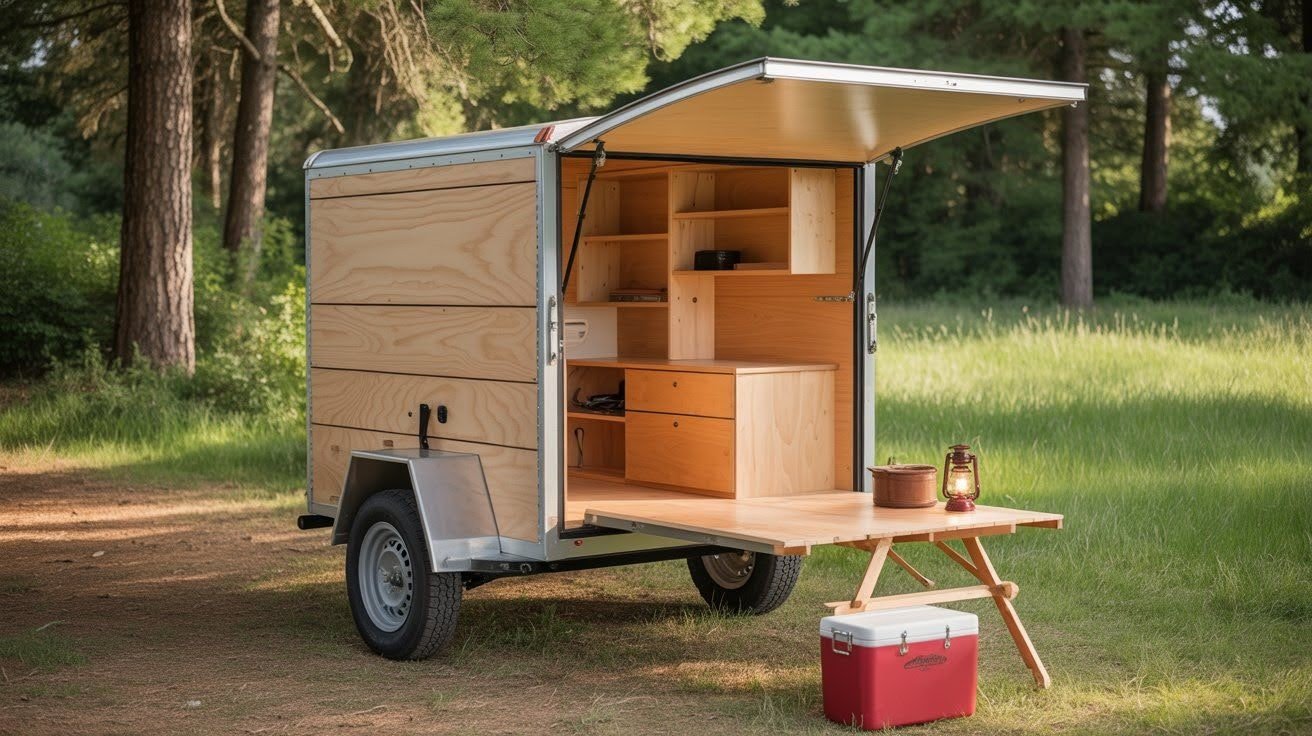
A simple box shape on a 5×8 utility trailer creates a straightforward camping space. This design uses basic building techniques that anyone with some carpentry knowledge can handle. You don’t need fancy angles or complicated cuts.
The boxy interior gives you more usable space than curved designs. Install shelves, cabinets, and hooks to keep everything organized. A fold-down table or bed maximizes the area when you need it.
First-time builders should consider this project because it teaches fundamental skills. You can finish it in four to six weeks working part-time. The simple construction keeps material costs between $1,200 and $2,000.
6. Cedar Frame Natural Wood Trailer
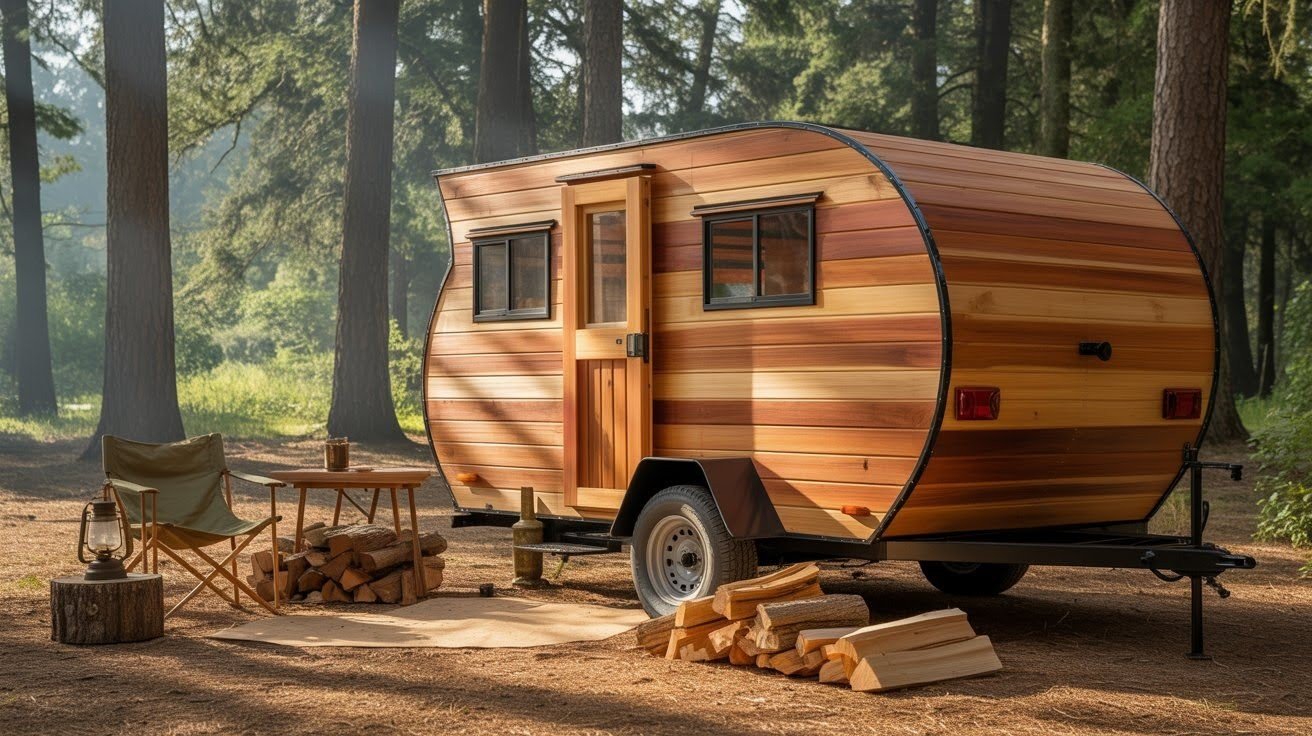
Cedar lumber naturally resists rot without needing chemical treatments. This wood weighs less than pressure-treated lumber, which helps keep your trailer light. Cedar also repels insects naturally, protecting your build for years.
The natural wood grain looks beautiful with just a clear coat or stain. You avoid the green tint of treated wood and get a warmer appearance. Cedar smells pleasant, too, making your camping space more inviting.
Eco-conscious builders who want natural materials choose this option. The wood handles weather well in most climates. Budget around $2,000 to $3,000 for materials, with cedar costing more than standard lumber.
7. Expandable Pop-Up Style DIY Trailer
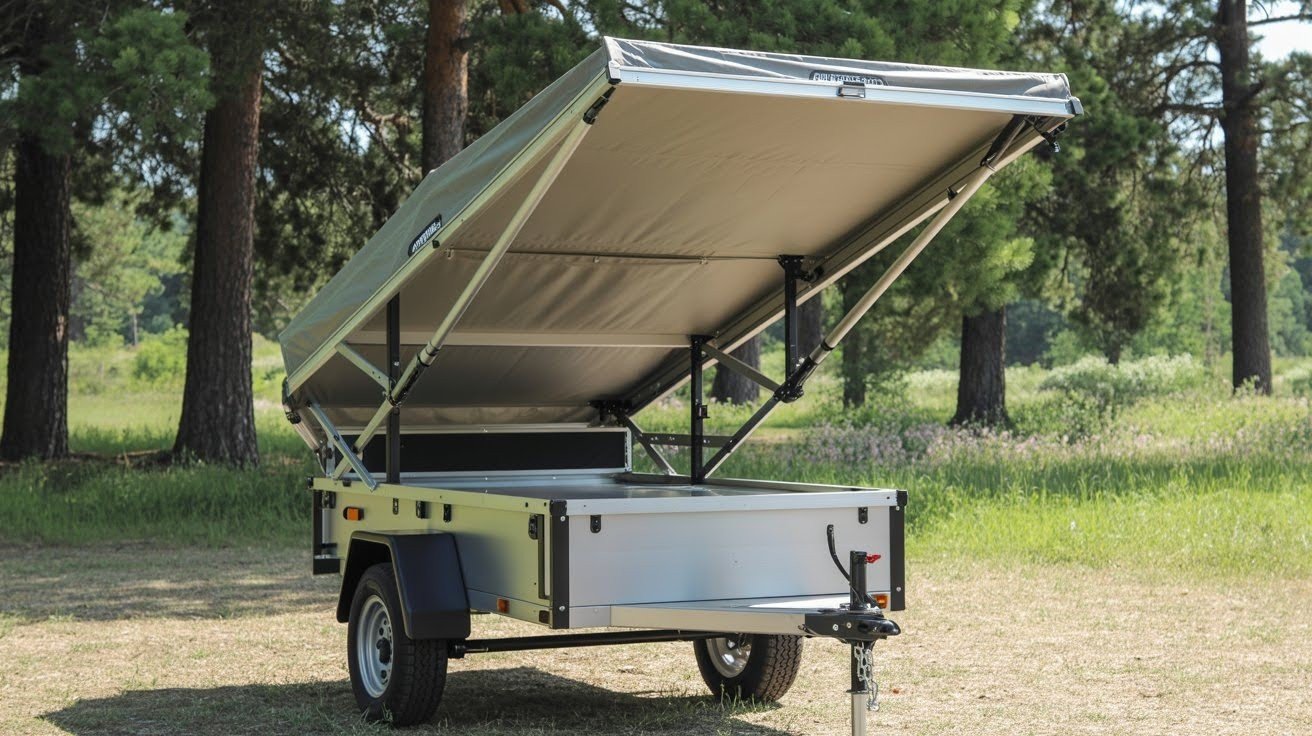
This collapsible design folds down flat for easier towing and storage. When collapsed, it creates less wind resistance and improves your gas mileage. You can park it in a standard garage when not in use.
Canvas or vinyl sides attach to the frame and fold down during travel. Pop them up at the campsite for full walls. A telescoping roof system raises up to give you standing room inside. Lower it back down when you hit the road.
People with limited home storage space benefit most from this design. The collapsed height makes it easier to tow in windy conditions. This remains one of the more complex diy camping trailer ideas, but offers great versatility.
Essential Tips for Building Your DIY Camping Trailer

Building your own trailer takes planning and attention to detail. These tips help you avoid common mistakes and create something that lasts. Following these guidelines makes the construction process smoother from start to finish.
- Plan for weight distribution: Keep total weight under your vehicle’s towing capacity, accounting for cargo and supplies
- Prioritize weatherproofing: Use quality caulk, liquid nails, and proper flashing to prevent water infiltration.n
- Check square frequently: Use a speed square throughout construction to ensure structural integrity..ty
- Choose appropriate materials: Balance weight, cost, and durability based on your specific needs.
- Don’t skip insulation: Even basic insulation improves comfort across different weather conditions.
- Install proper wiring: Follow trailer lighting regulations for safe road travel.l
- Test fit before final assembly: Dry fit components to catch measurement errors early
- Consider multi-use functionality: Design features that allow alternative us, es as motorcycle hauling or storage.
- Research local regulations: Check registration requirements for homemade trailers in your area
- Budget for unexpected costs: Add a 15 to 20 percent buffer to your estimated materials budget
Taking your time during construction pays off with a better final product. Rush jobs lead to problems down the road. Measure twice and cut once to save materials and frustration.
Conclusion
You now have several diy camping trailer ideas to choose from based on your skills and budget. Each design offers different benefits for different types of campers. Some focus on light weight while others maximize living space.
Building your own trailer gives you something that fits your exact camping style. You save money compared to buying a manufactured camper. The satisfaction of creating something with your own hands makes every camping trip more special.
Start by picking the design that excites you most. Make a list of materials and tools you’ll need. Set a realistic timeline based on how much time you can dedicate each week.
Online forums and social media groups connect you with other DIY trailer builders. They share tips, answer questions, and offer encouragement when you hit snags.
Frequently Asked Questions
What Is The Cheapest Material For Building A Camping Trailer?
Foam core panels cost the least and weigh almost nothing. Basic plywood runs a close second at around $30 to $50 per sheet. Used materials from salvage yards can cut costs even more if you’re patient.
How Long Does It Take To Build A DIY Camping Trailer?
Simple builds take two to four weeks, working on weekends. More complex designs need two to four months. Your skill level and available time determine the actual timeline for your specific project.
Do I Need Special Tools To Build My Own Trailer?
Basic hand tools like a saw, drill, hammer, and measuring tape get you started. A circular saw and impact driver speed things up significantly. Most builders already own these tools or can borrow them from friends.
Can A Wooden Trailer Frame Be As Durable As Metal?
Properly treated wood lasts 10 to 15 years with regular maintenance. Metal frames can last 20-plus years but cost more and rust without proper care. Cedar and marine-grade plywood offer the best durability for wood options.
What Size Trailer Is Best For First-Time Builders?
A 4×8 or 5×8 trailer works best for beginners learning the construction process. These sizes are easier to handle and require less material. You can finish them faster and gain confidence before attempting larger diy camping trailer ideas.

